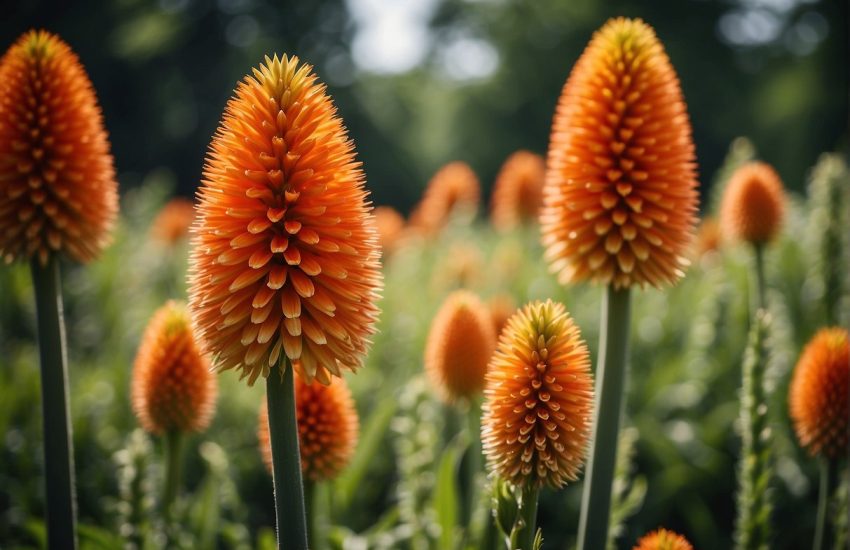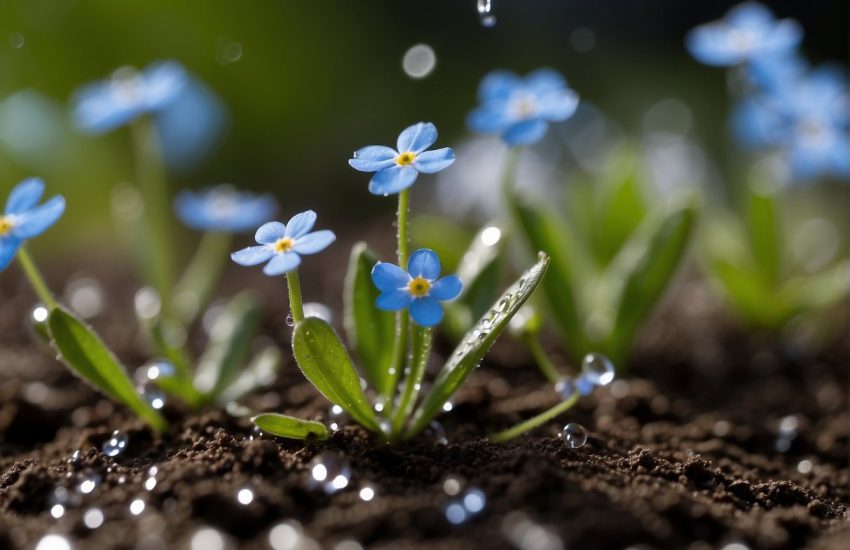Attracting Hummingbirds with Perennials: Best Plant Choices and Care Tips
You can attract hummingbirds to your garden by picking the right perennials. These plants offer a steady source of nectar, which hummingbirds hunt for during migration and breeding.
Go for perennials with brightly colored, tubular flowers—they’re magnets for hummingbirds.
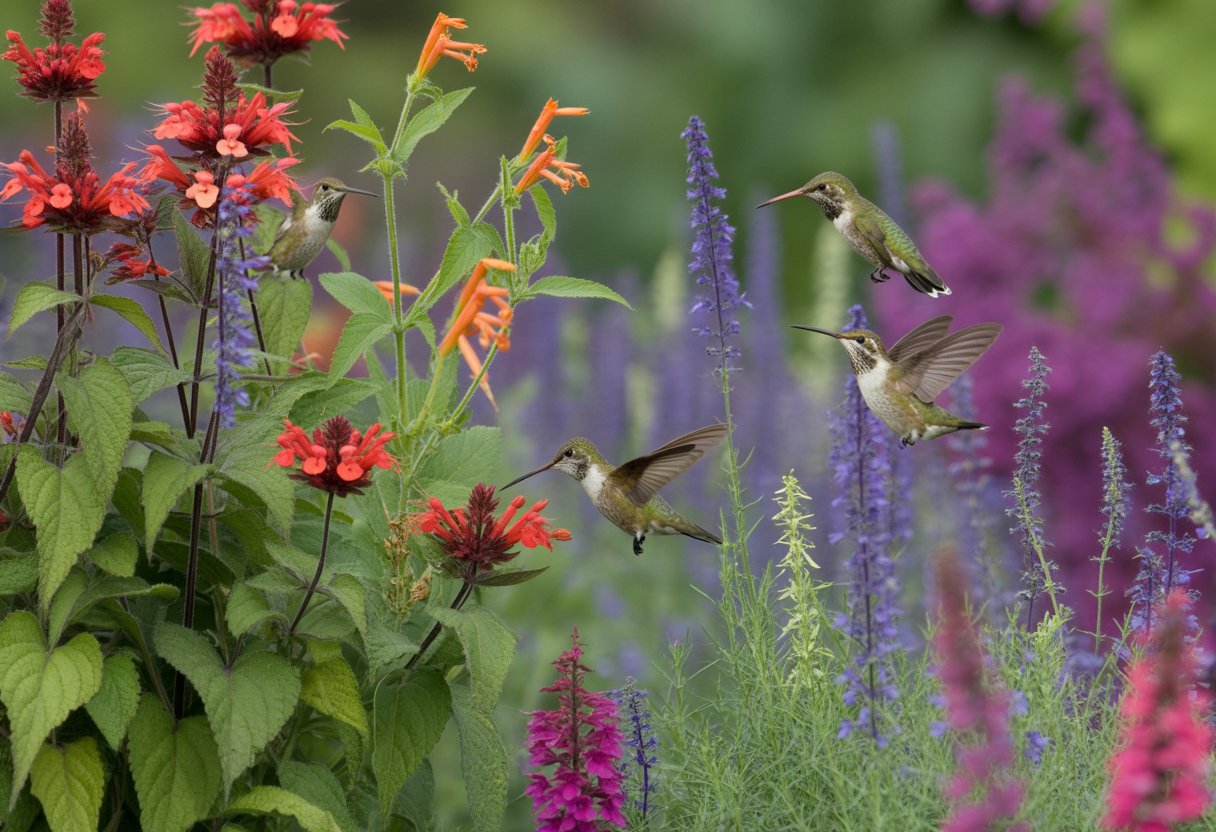
Bee balm, coral bells, and columbine are solid choices. Their shapes and colors just seem to call out to hummingbirds.
Since these perennials return every year, they’re a smart investment if you’re hoping to create a hummingbird-friendly space. If you plant and care for them thoughtfully, you’ll turn your garden into a lively spot for these speedy little birds.
Hummingbirds like flowers that bloom at different times. Mixing your perennials keeps nectar available and brings them back season after season.
Understanding Hummingbirds and Their Needs

Hummingbirds need more than just pretty flowers. They rely on accessible food and the right plants to make it through the year.
Their feeding habits, dependence on native plants, and migration patterns all play a role in whether they’ll stick around your yard.
Hummingbird Feeding Habits
Nectar is the main fuel for hummingbirds. It’s loaded with sugar, which they burn through at an astonishing rate.
They’re built for deep, tubular flowers—their long bills and tongues can reach nectar that most insects can’t touch. But it’s not just nectar; they also snap up tiny insects and spiders for protein, which helps with muscle and egg development.
You’ll usually see them feeding throughout the day, especially in the morning and late afternoon. They can get pretty territorial about good nectar spots, so where you put your flowers matters.
If you plant a variety of flowering plants, you’ll give different hummingbird species (and personalities) a reason to visit.
Importance of Native Plants
Native plants and hummingbirds have sort of grown up together. These plants offer the right kind of nectar and flower shapes that local hummingbirds expect.
Native perennials tend to have richer nectar, which matches what hummingbirds need. They also attract the insects hummingbirds like to eat.
If you want to keep it simple, pick perennials like bee balm, columbine, and trumpet creeper. They’re proven winners for hummingbird habitats.
Role of Migration and Seasonality
Hummingbirds travel impressive distances between breeding and wintering grounds. Their arrival depends a lot on when plants bloom.
If your garden has flowers blooming from early spring to fall, you’ll support them when they show up—and right before they leave. Early flowers help new arrivals, and late bloomers give them a boost before migration.
If you stagger your perennials’ bloom times, you’ll match the birds’ needs and make life a bit easier for them.
Choosing the Best Perennials for Attracting Hummingbirds
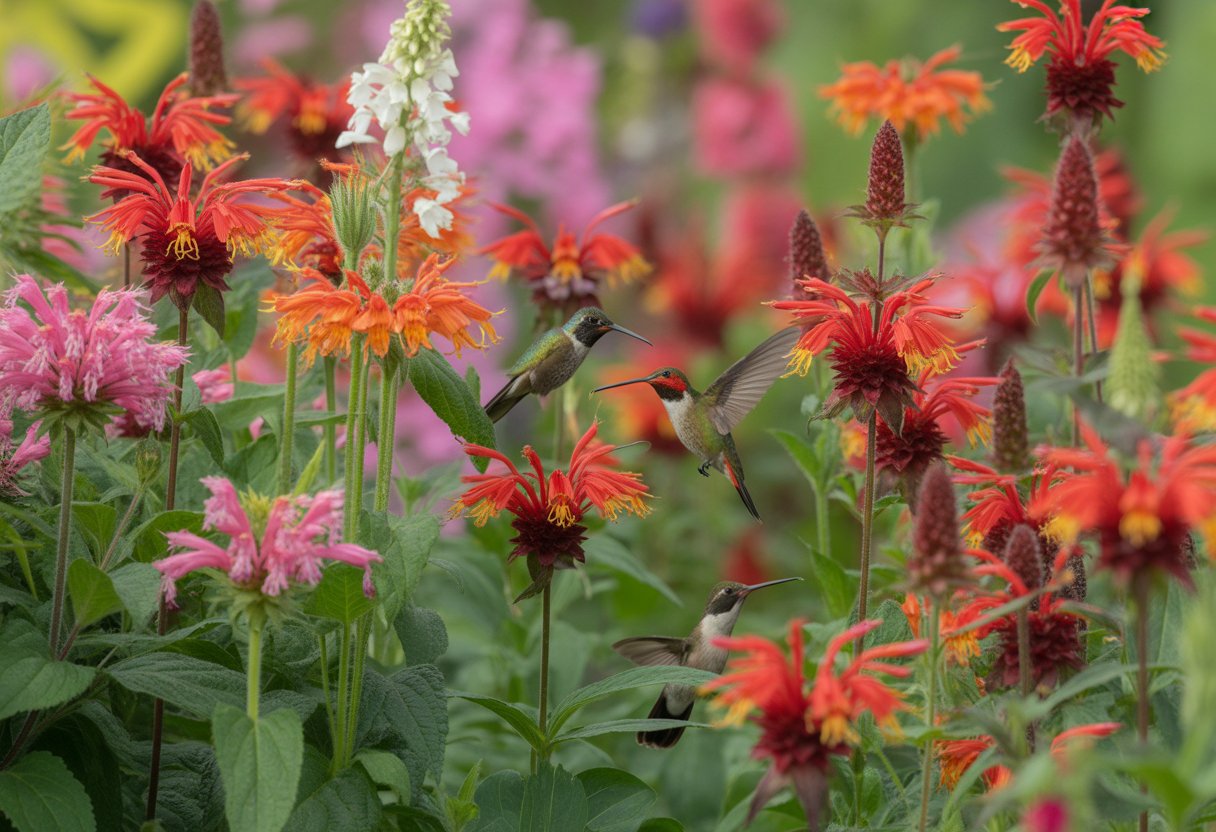
Picking the right perennials can make or break your hummingbird garden. Focus on how the flowers look, their color, and how tough they are.
Top Perennial Flower Types
Salvia, bee balm, penstemon, and hummingbird mint are all big hits with hummingbirds. These plants just crank out nectar.
Beardtongue (Penstemon) has tubular flowers that fit hummingbird beaks perfectly. Bee balm’s bright clusters attract not only hummingbirds but other pollinators, too.
Blazing star and garden phlox add some height and color variety. Coral bells bring in interesting foliage and dainty flowers. Daylilies can work, but honestly, they’re not hummingbirds’ top pick.
Red and Tubular Flowers
Hummingbirds are suckers for red, tubular flowers. Cardinal flower and kniphofia stand out for their bold red blooms and shape.
These flowers basically roll out the red carpet for hummingbirds, making feeding easy and efficient. The tubular shape also keeps out nectar thieves that don’t help pollinate.
Salvia and columbine come in lots of red shades and bloom at different times. Planting several kinds of red flowers can really ramp up your garden’s appeal.
Drought-Tolerant and Deer-Resistant Selections
If you choose drought-tolerant perennials like blazing star or some salvias, you’ll save yourself work during dry spells. These plants still offer plenty of nectar.
Coral bells and garden phlox are better at handling deer, which is handy if you’ve got hungry wildlife around. They keep blooming even if a few leaves get munched.
A mix of drought-tolerant and deer-resistant plants makes your hummingbird garden more sustainable. Try to balance nectar supply with plants that can handle your local conditions.
Designing a Hummingbird-Friendly Perennial Garden
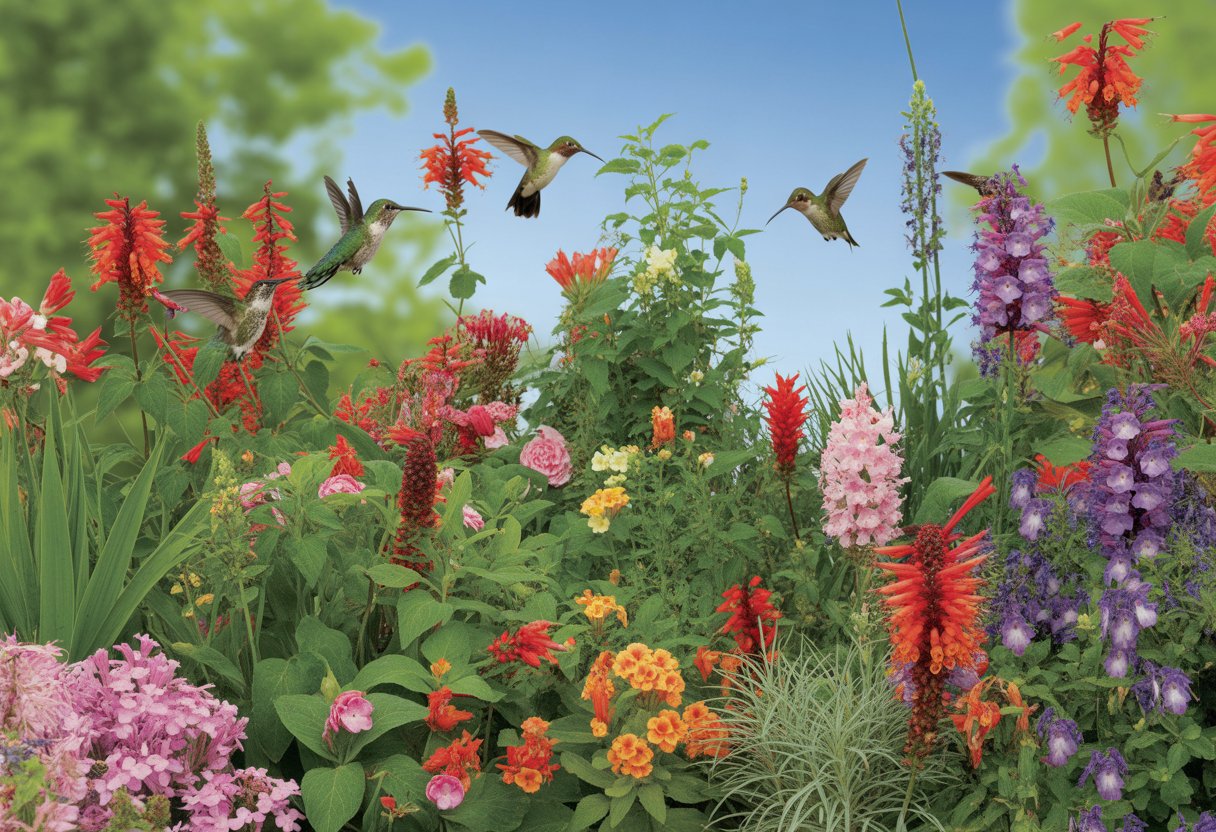
Setting up a hummingbird-friendly perennial garden takes a bit of planning. You’ll want to think about where you put your plants, the soil, sunlight, and how everything fits together.
All these pieces help hummingbirds feed easily and stick around.
Optimal Placement and Garden Layout
Hummingbirds like gardens where they can zip around and find nectar-rich flowers without much effort. Planting perennials in clusters, not just scattering them, makes feeding more efficient.
Try grouping plants by when they bloom, so something’s always in flower. Put your garden in a full sun spot—at least 6 hours of direct sunlight is ideal.
If you add a path or a bench nearby, you can watch the birds without scaring them off. Layering plants by height—tall ones in back, shorter ones in front—gives hummingbirds shelter and makes it easier for them to find flowers.
Soil and Sunlight Requirements
Good soil is the foundation for healthy perennials. Go for well-draining soil with lots of organic matter.
If you’re not sure about your soil’s pH, test it. Some perennials can be picky.
Most hummingbird-friendly perennials want full sun, but a little afternoon shade is okay. More sun usually means more nectar.
Keep the soil evenly moist, especially when it’s hot and dry, to keep those blooms coming. Mulch helps lock in moisture and keeps weeds down.
Don’t go overboard with fertilizer—too much can make plants leafy instead of flowery, which isn’t what hummingbirds want.
Combining Perennials with Shrubs and Trees
Flowering shrubs can add structure and keep the show going longer. Azaleas or butterfly bush, for example, offer extra nectar and sometimes nesting spots.
Put shrubs around the edges so they don’t shade your perennials too much. Trees can give hummingbirds perches and places to nest.
Pick trees with open branches and flowers or fruit that hummingbirds like. Just make sure they don’t block all the sun from your perennials.
If you combine perennials, shrubs, and trees, you’ll end up with a layered habitat that’s more attractive and lasts longer.
Supporting Hummingbirds Beyond Perennials
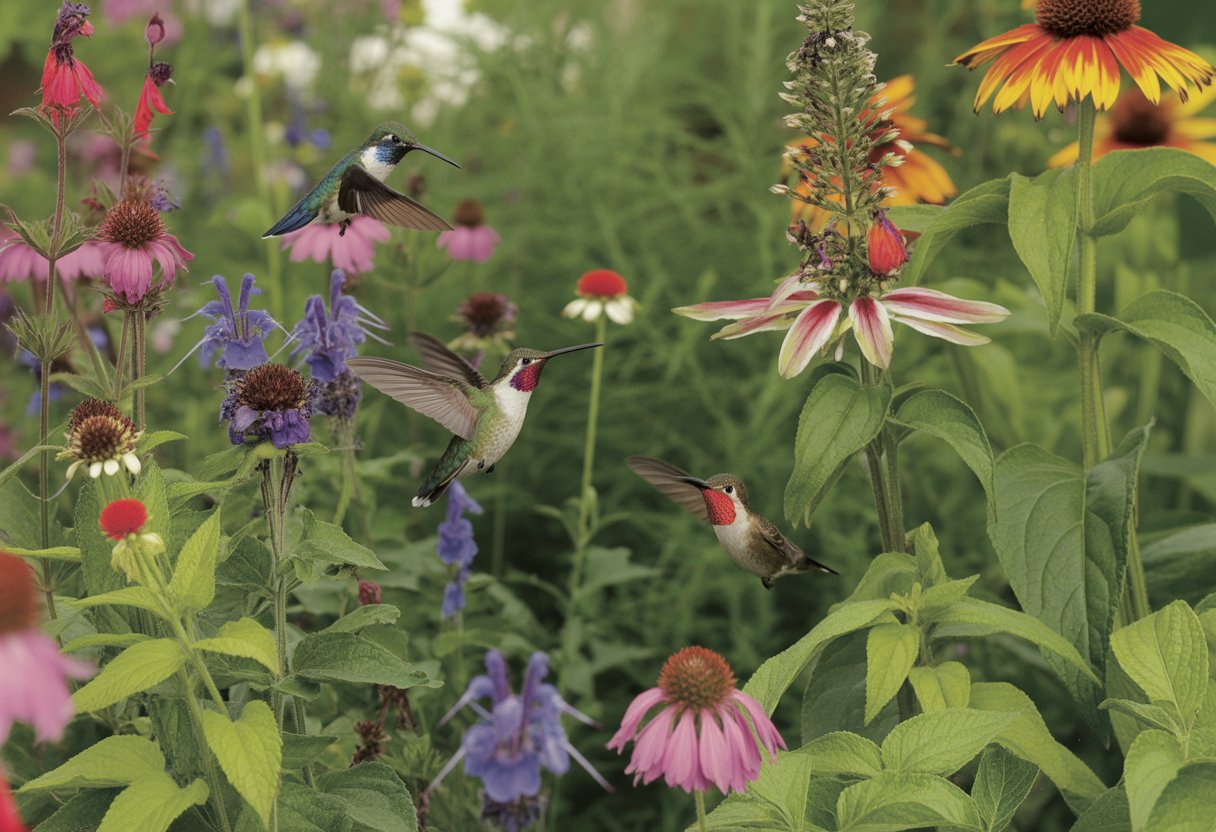
Giving hummingbirds more than just flowers helps keep them coming back. Safe gardening and inviting other pollinators make your space even more appealing.
Supplemental Nectar and Feeders
Feeders can fill in the gaps when flowers aren’t blooming. Mix up a batch with four parts water to one part white sugar—boil it, then let it cool.
Clean feeders every 3-5 days. That’s a bit of a chore, but it keeps bacteria and mold away.
Skip the red dye; it’s not safe for birds. Natural nectar sources like trumpet creeper and petunia can also help when food is scarce.
Place feeders in shady spots near your perennials. That keeps the nectar from getting too hot and invites more birds in.
Safe Gardening Practices
Pesticides are a no-go—they’re dangerous for hummingbirds and the insects they eat. The Audubon Society suggests organic pest control methods like neem oil or insecticidal soap.
If you stick with native plants, you’ll need fewer chemicals anyway. Native gardens support local bugs, which hummingbirds rely on for protein.
Mulch and regular watering can help control weeds and keep plants healthy without harsh chemicals. That’s good news for both your plants and your feathered guests.
Attracting Other Beneficial Pollinators
Supporting pollinators like bees and butterflies does wonders for the garden ecosystem. These insects pollinate flowers and boost nectar supplies for hummingbirds.
Try planting a mix of native flowers that bloom at different times. That way, you’ll keep food available all season.
Set out shallow water dishes or even a muddy spot—pollinators love that sort of thing.
Mixing in herbs and wildflowers draws in good bugs and keeps pests away. A more balanced garden means happier hummingbirds, too.

